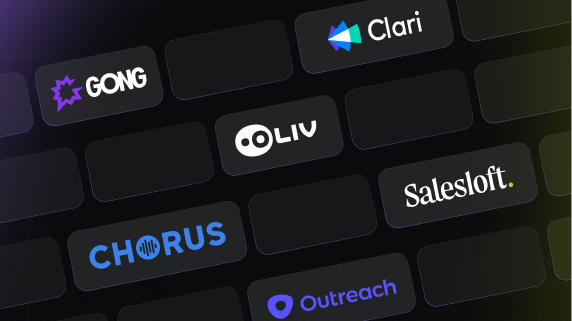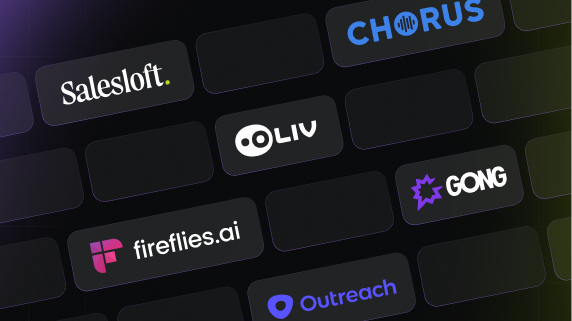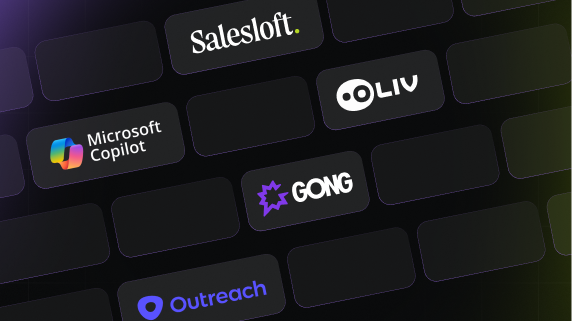Q1. What are the 9 Best Revenue Intelligence Tools for Sales Teams in the AI-Era? [toc=Best Revenue Intelligence Tools]
The revenue intelligence market in 2026 stands at a critical inflection point. Sales leaders evaluating platforms face a fundamental choice between legacy tools built on pre-generative AI architectures requiring extensive manual adoption and next-generation AI-native platforms that autonomously execute revenue workflows. This comprehensive analysis examines nine leading revenue intelligence platforms, comparing their technological foundations, operational capabilities, pricing transparency, and real-world performance based on verified user feedback and market analysis.
The platforms analyzed below represent distinct categories within the revenue intelligence landscape: AI-native orchestration platforms (Oliv AI), conversation intelligence pioneers (Gong, Chorus.ai), forecasting specialists (Clari), sales engagement leaders (Salesloft, Outreach), CRM-native AI solutions (Salesforce Einstein), Salesforce-integrated intelligence (Revenue Grid), and data-first prospecting tools (Apollo). Each platform's positioning, strengths, limitations, and ideal use cases are evaluated through the lens of 2026 market requirements.
The 9 Leading Revenue Intelligence Platforms
- Oliv AI - AI-Native Revenue Orchestration Platform
- Gong - Conversation Intelligence & Revenue AI
- Clari - Enterprise Forecasting & Pipeline Management
- Salesloft - Sales Engagement & Cadence Automation
- Outreach - Sales Execution & Sequencing Platform
- Chorus.ai by ZoomInfo - Conversation Analytics Add-on
- Salesforce Einstein - CRM-Native AI Intelligence
- Revenue Grid - Salesforce Activity Capture & Guidance
- Apollo - Data-Driven Sales Intelligence & Prospecting
⭐ Comprehensive Platform Comparison Matrix
*Requires ZoomInfo platform purchase ($10K+ annually)
1. Oliv AI - AI-Native Revenue Orchestration Platform ⭐⭐⭐⭐⭐ [toc= 1. Oliv AI]
What It Does
Oliv AI represents the first true AI-Native Revenue Orchestration platform, architected from the ground up on generative AI and autonomous agent technology rather than retrofitting AI capabilities onto legacy SaaS infrastructure. Unlike traditional tools requiring sales teams to log into dashboards, configure workflows, and manually interpret insights, Oliv deploys specialized AI agents that autonomously execute end-to-end revenue workflows from CRM hygiene and forecasting to personalized prospecting and automated coaching directly where revenue teams already work (email, Slack, CRM).
The platform's architecture solves the "$500/user fragmentation problem" plaguing mid-market and enterprise buyers who historically stacked Gong ($250/user) for conversation intelligence with Clari ($200/user) for forecasting, creating data silos, workflow redundancy, and doubled expenses. Oliv unifies conversational intelligence, bottom-up forecasting, sales engagement, and CRM automation into a single platform while maintaining modular agent pricing, allowing organizations to purchase only needed capabilities.
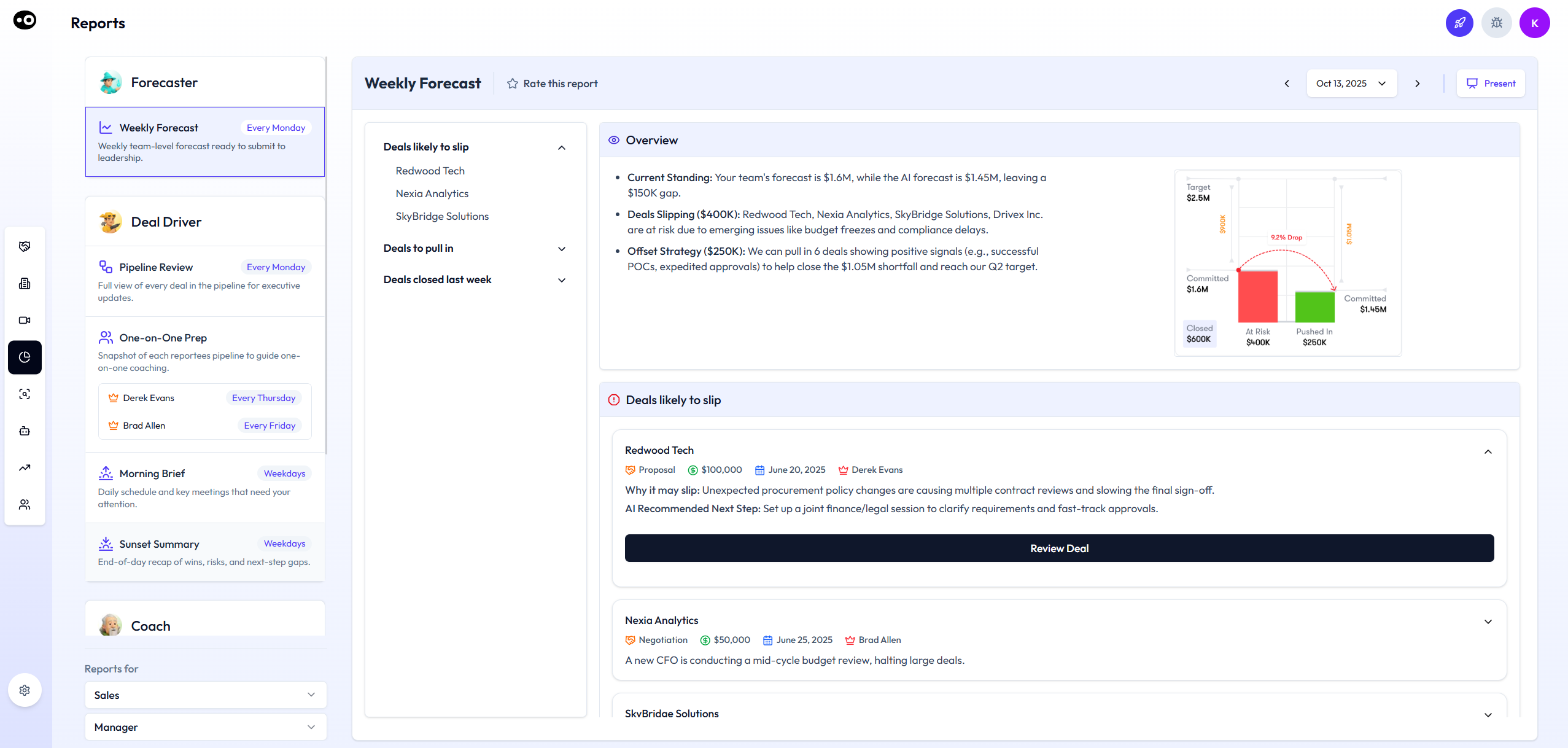
✅ Key Features & AI Agents
Oliv's differentiation stems from its specialized AI agent architecture, where each agent owns a complete workflow rather than providing passive insights:
- Forecaster Agent: Automates bottom-up forecasting by analyzing deal-level signals across calls, emails, and CRM data to generate unbiased AI forecasts, identify at-risk deals with specific remediation actions, and produce one-page presentation decks for Monday forecast meetings eliminating the 8-10 hours weekly managers spend manually reviewing pipeline
- CRM Manager Agent: Populates structured CRM fields automatically (not just notes like Gong), creating/enriching contacts, mapping accounts, updating opportunity stages, and capturing unstructured conversation insights into custom fields solving the "CRM data hygiene crisis" where 70% of CRMs contain incomplete data
- Prospector/Researcher Agent: Performs deep account research (LinkedIn, Crunchbase, news, tech stack), builds custom account plans with ICP fit scoring, identifies buying committee members, and generates personalized email drafts addressing the shift from bulk prospecting to research-driven, tailored outreach
- Deal Driver Agent: Flags at-risk opportunities based on stakeholder sentiment, buying committee engagement gaps, and competitive mentions, delivering weekly pipeline breakdowns for manager 1-on-1s
- Coach Agent: Automatically scores every conversation against MEDDIC/BANT/SPICED frameworks, identifies rep performance gaps, and delivers automated coaching workflows without manual scorecard creation
- Voice Agent (Pipeline Tracker): Calls reps nightly for hands-free pipeline updates, capturing insights from unrecorded meetings (in-person, sensitive calls, phone conversations) a unique capability generating significant market interest
- Meeting Assistant Agent: Pre-meeting account research, live note-taking, automated follow-up email drafting, and CRM activity logging
💰 Pricing & Implementation
Oliv's transparent, value-based pricing structure contrasts sharply with legacy vendors' hidden platform fees and implementation charges:
Core Intelligence Tiers:
- Free Tier: Unlimited meeting recordings and transcriptions ($0/user)
- Starter: AI summaries, chapters, next steps ($19/user/month)
- Standard: Meeting insights for Sales/CS/TA ($49/user/month)
- Supreme: Deal scorecards (MEDDIC/BANT), combined call/email intelligence ($89/user/month)
Modular AI Agents (purchase only what's needed):
- Forecaster Agent, Deal Driver, Coach Agent, CRM Manager Agent, Prospector Agent available as standalone add-ons
No Hidden Costs: Zero platform fees, zero implementation fees, zero training charges addressing the enterprise buyer frustration with Gong's implementation timelines and $30K+ onboarding costs
Special Offer for Gong Users: Free Starter tier, discounted Standard ($19 vs. $59), and discounted Supreme ($39 vs. $99)
Implementation: 1-2 weeks for enterprise deployments vs. 3-6 months for Gong/Clari; self-serve onboarding for SMBs takes 48 hours
✅ Pros
- Unified platform economics: Single solution replacing Gong + Clari stack at 80% lower total cost of ownership, eliminating data silos and vendor management overhead
- Generative AI-native architecture: GPT-first foundation enables true contextual understanding (distinguishing "prospect mentioned competitor" vs. "actively evaluating competitor") vs. keyword tracking
- Autonomous agent workflows: AI performs work proactively (updates CRM, generates forecasts, drafts emails) vs. requiring manual dashboard reviews and task creation
- Deal-level intelligence: Holistic view across entire sales cycle (all calls, emails, meetings) vs. meeting-level analysis
- Transparent pricing: Modular agent purchase with no platform/implementation fees vs. Gong's escalating bundled costs
- Fast time-to-value: 1-2 week deployments with <5 hours training required vs. months-long implementations
- RevOps-friendly: Spreadsheet-like interface for bulk analysis, full data export policy, maintains CRM as single source of truth addressing "wonky API" frustrations with Gong
❌ Cons
- Market awareness: Newer entrant vs. established brands (Gong founded 2015, Clari 2013) means less brand recognition despite superior technology
- Feature breadth vs. depth: While Oliv covers CI + Forecasting + Engagement + CRM automation, specialists like Gong have deeper conversation intelligence feature sets accumulated over decade of development
- Ecosystem integrations: Smaller third-party app marketplace compared to Salesforce/Gong ecosystems (though core integrations Salesforce, HubSpot, Zoom, Google Meet fully supported)
🎯 Use Cases & Ideal Customer Profile
Best For:
- Mid-market companies (50-500 employees) seeking to avoid the "Gong + Clari" double-stack trap costing $500/user/month
- Startups (<50 employees) requiring fast deployment, transparent pricing, and no platform fees ($5K minimum with Gong)
- Enterprise organizations (500+ employees) prioritizing TCO reduction, data portability (full export policy), and RevOps efficiency (no custom API coding required)
- Sales teams transitioning from legacy tools frustrated by manual forecast prep, CRM data hygiene issues, and high renewal costs
💬 Real User Feedback
"Oliv AI eliminates the 'SaaS adoption tax' entirely. We went from 15 hours per week cleaning CRM data to 2 hours reviewing automated updates. The Forecaster Agent produces better bottom-up forecasts than our manual Clari process, and implementation took 10 days vs. the 6 months Gong quoted us."
RevOps Director, Mid-Market SaaS Company
"The Voice Agent is a game-changer for capturing insights from in-person customer meetings and phone calls that aren't recorded. Our reps actually use it because it's a 2-minute call vs. 20 minutes manually updating Salesforce."
VP of Sales, Series B Startup
2. Gong - Conversation Intelligence & Revenue AI ⭐⭐⭐⭐ [toc= 2. Gong]
What It Does
Gong pioneered the conversation intelligence category in 2015 and remains the market leader in call recording, transcription, and conversation analytics. The platform captures sales calls, emails, and meetings, applying keyword-based "Smart Trackers" to identify competitive mentions, feature requests, and deal risks. Gong's strength lies in its comprehensive conversation library, coaching scorecards, and integration ecosystem built over a decade of market presence.
However, Gong's pre-generative AI architecture constrains its capabilities. The platform relies on keyword tracking and basic activity signals (email counts, meeting frequency) rather than contextual understanding, struggling to distinguish nuanced scenarios like whether a prospect casually mentioned a competitor versus actively evaluating multiple vendors. This limitation becomes critical for accurate forecasting and deal risk assessment.
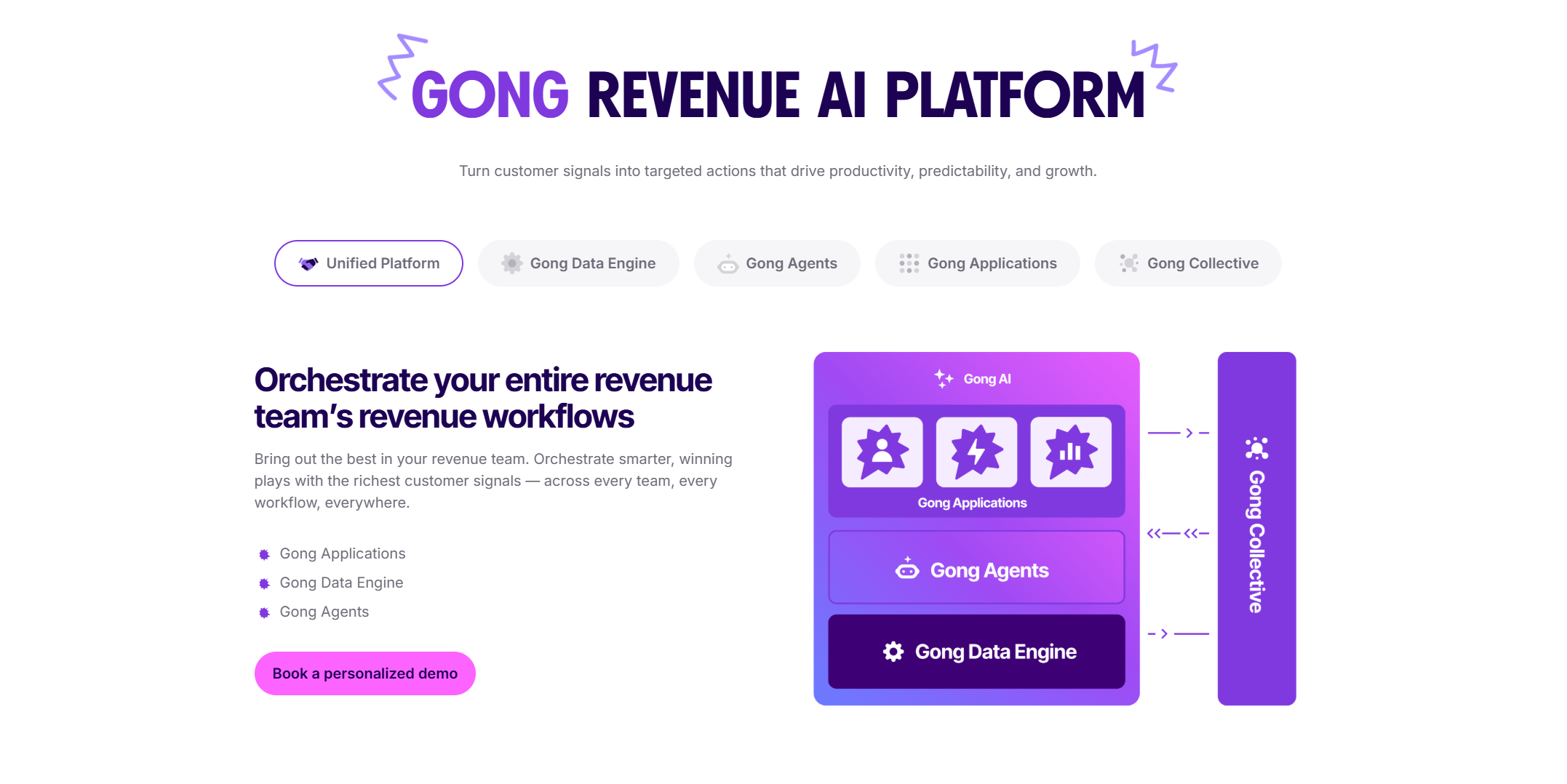
🔧 Key Features
- Conversation capture & analysis: Records calls/meetings, generates transcripts, and applies keyword trackers to identify patterns
- Smart Trackers: Monitors competitor mentions, objections, pricing discussions, and custom keywords
- Call libraries & coaching: Curated call collections for rep training and manager coaching workflows
- Deal boards: Centralized view of conversations, emails, and CRM data per opportunity
- Forecasting module (Gong Forecast): Roll-up forecasting with activity-based risk scoring (rated 4/10 by market analysts vs. Clari's forecasting strength)
- Sales engagement (Gong Engage): Cadence automation and task management (criticized for "numerous issues" in user reviews)
💰 Pricing
Gong's pricing structure presents a significant pain point for buyers, with substantial hidden costs beyond advertised per-user rates:
- Bundled pricing: ~$250/user/month (includes Engage + Forecast + Conversation Intelligence, previously $160/user unbundled)
- Platform fees: $5,000 base platform fee + $5,000 per 25 additional users
- Implementation costs: $10,000-$30,000 for 100-person teams
- Complex 3-6 month implementation cycles requiring dedicated RevOps resources
- Annual contracts with auto-renewal: Users report difficulty negotiating mid-contract adjustments despite downsizing
✅ Pros
- Market leader reputation: Decade of category leadership provides brand trust and extensive case studies
- Comprehensive conversation library: Deep feature set for call recording, playback, and playlist curation
- Integration ecosystem: Mature integrations with Salesforce, HubSpot, Outreach, Salesloft, and 50+ third-party tools
- UI polish: Clean interface and thoughtful UX design praised by users
❌ Cons
- Pre-AI keyword tracking: Smart Trackers miss contextual nuance, providing "very poor picture of the deal" cannot distinguish mention vs. active evaluation
- High total cost of ownership: $250/user + platform fees + $30K implementation = prohibitive for mid-market; users report "paying too much" and feeling "stuck"
- Fragmented stack: Strong on CI but weak forecasting (4/10) forces Gong + Clari dual purchase at ~$500/user/month
- "Wonky" API: RevOps teams report needing extensive custom code to extract data for analysis, creating maintenance burden
- Meeting-level analysis: Analyzes conversations in isolation, missing deal-level context across full sales cycle
- 20-30 minute recording delay: Insights not available immediately post-call
- Gong Engage underperformance: Sales engagement module criticized for "low adoption," "slow and buggy" experience, lacking integrations
- Implementation complexity: 3-6 month cycles with minimal ongoing support; users report being "left with minimal support" post-onboarding
🎯 Use Cases & Ideal Customer Profile
Best For:
- Enterprise organizations (500+ employees) with existing Gong deployments where sunk costs and trained users make switching disruptive
- Teams prioritizing conversation intelligence exclusively and willing to accept weak forecasting/engagement capabilities
- Well-funded companies with $250+/user budgets and RevOps resources to manage complex implementations
💬 Real User Feedback
"While Gong offers valuable insights into call data and sales interactions, our experience has been impacted by significant data access limitations, especially concerning data portability and bulk export capabilities. If you're considering switching platforms and have six months or less on your contract, start engaging the Gong API documentation immediately to download all of your call data in a usable format. This lack of flexibility has required us to engage our development team at additional cost."
Neel P., Sales Operations Manager, Small Business, G2 Verified Review
"The additional products like forecast or engage come at an additional cost. Would be great to see these tools rolled into the core offering. It's probably the highest end option on the market."
Scott T., Director of Sales & Iris P., Head of Marketing, G2 Verified Review
"Gong is a really powerful tool but it's probably the highest end option on the market, and now we're stuck with a tool that works technically but isn't the right business decision. Having talked with other friends who lead revenue functions, all have said the same thing they've been fine using a lower cost, simpler alternative."
Iris P., Head of Marketing, Mid-Market Company, G2 Verified Review
3. Clari - Enterprise Forecasting & Pipeline Management ⭐⭐⭐⭐ [toc= 3. Clari]
What It Does
Clari built its reputation on roll-up forecasting, automating the manual process of consolidating rep-level forecasts up through managers to VP/C-level leadership. The platform excels at providing analytics for higher-level leaders, offering waterfall analysis, pipeline inspection, and forecast accuracy tracking. Clari's UI and forecasting visualization are frequently praised as superior to native Salesforce capabilities.
However, Clari's expansion into conversation intelligence (Copilot product) and sales engagement (Groove product) has created a "jack-of-all-trades, master-of-one" positioning. Users consistently report that Clari's CI capabilities pale compared to Gong, forcing the dual-tool purchase that creates the $500/user/month stack problem Oliv AI solves.
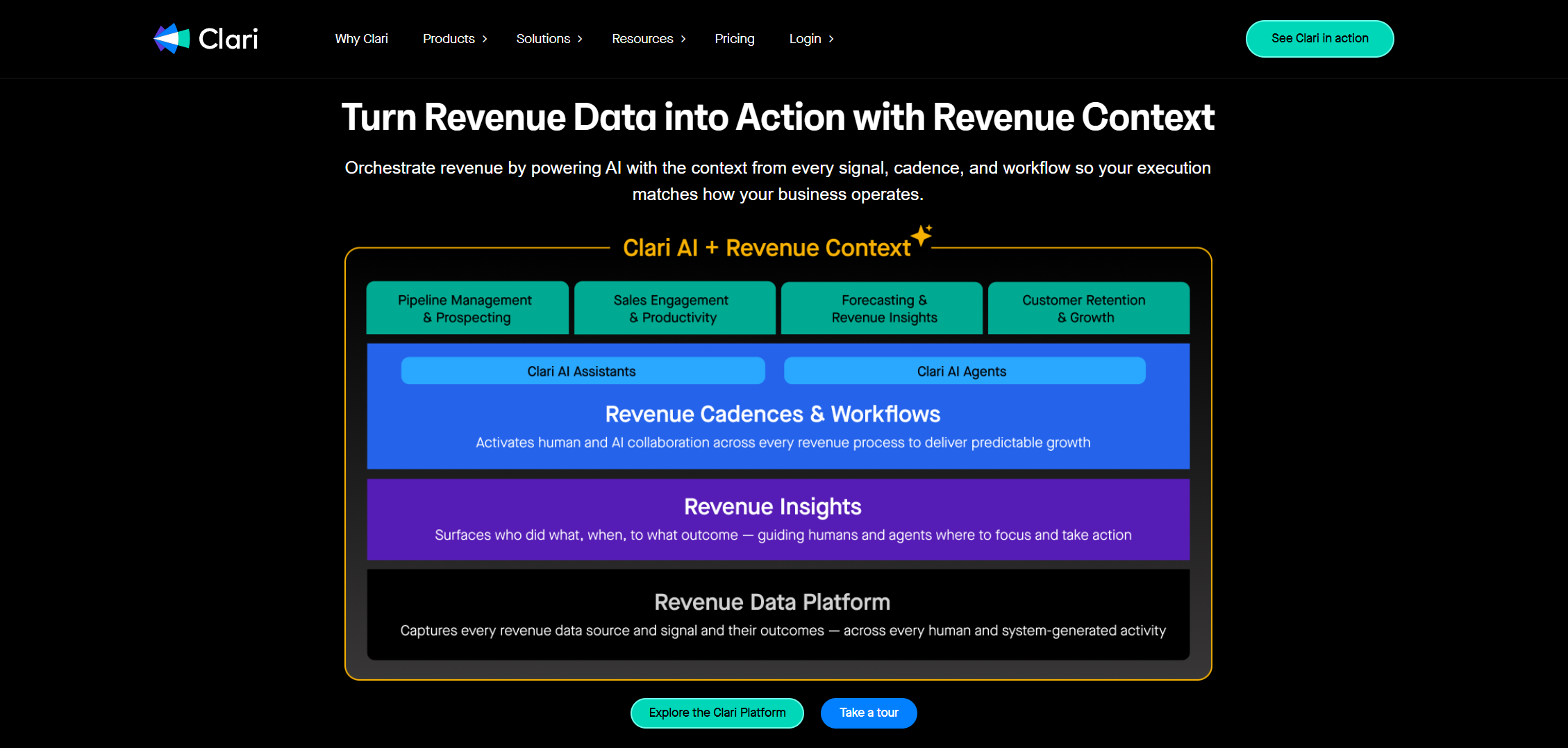
🔧 Key Features
- Roll-up forecasting: Automates forecast consolidation from rep to manager to VP to CRO with configurable hierarchies
- Waterfall analysis: Visualizes pipeline changes (slippage, pull-ins, new deals) over time
- Pipeline inspection: Drag-and-drop deal management with inline field editing synced to Salesforce
- Analytics modules: Pre-built reports on conversion rates, velocity, and forecast accuracy
- Copilot (Conversation Intelligence): Clari's CI product, considered "weaker than Gong's" by market consensus
- Groove (Sales Engagement): Email sequencing and cadence management acquired to compete with Salesloft/Outreach
💰 Pricing
- Core platform: $100-$200/user/month depending on modules (Copilot, Groove add-ons)
- Platform fees, implementation charges, and onboarding costs similar to Gong's model
- Complex hierarchy setup requiring RevOps resources and Salesforce user licenses for forecast nodes
✅ Pros
- Best-in-class forecasting UI: Clean, intuitive interface preferred over Salesforce by sales leadership
- Strong analytics: Waterfall, funnel, and trend charts provide valuable pipeline visibility
- Salesforce integration depth: Real-time bi-directional sync with minimal latency
- VP/C-level focus: Designed for leadership-level forecast reviews vs. rep-level workflows
❌ Cons
- Weak conversation intelligence: Copilot product "necessary to compete with Gong" but fails to match CI quality, forcing dual-tool purchases
- Activity-based signals: Like Gong, relies on pre-AI activity tracking (email counts, meetings) that miss nuanced deal risks
- Manual roll-up dependency: Still requires rep forecast inputs and manager reviews despite automation of consolidation layer
- Fragmentation problem: Users pay $100/user for Clari forecasting + $250/user for Gong CI = $350-$500/user total stack
- Dashboard limitations: Users report dashboards are "too basic" with limited customization vs. Salesforce's flexibility
- Groove/Copilot underperformance: Both acquired products criticized Groove rated "worse than Outreach/Salesloft," Copilot weaker than Gong
🎯 Use Cases & Ideal Customer Profile
Best For:
- Enterprise VP/C-level leaders (1000+ employees) who prioritize Clari's specific roll-up UI and are willing to accept weaker CI
- Organizations with complex forecasting hierarchies requiring multi-level rollups with custom business rules
- Teams already using separate CI tool (e.g., Gong) and only needing forecasting layer
💬 Real User Feedback
"Clari makes it extremely easy to quickly get the information I need across many different teams and opportunities. The out of the box analytics are very helpful. However, Clari features often overlap with other common sales tech tools. Clari should do more to differentiate themselves from competition."
Sarah J., Senior Manager Revenue Operations, Mid-Market Company, G2 Verified Review
"I find the setup process challenging, especially when migrating fields from Salesforce, as it can't handle formula fields directly. This requires creating and maintaining duplicate fields, which adds complexity and workload. Additionally, I am disappointed with the limited configurability of dashboards."
Josiah R., Head of Sales Operations, Mid-Market Company, G2 Verified Review
For detailed comparisons, see Gong vs Clari and best Clari alternatives.
4. Salesloft - Sales Engagement & Cadence Automation ⭐⭐⭐ [toc= 4. Salesloft]
What It Does
Salesloft is a sales engagement leader specializing in SDR/BDR workflows cadence automation, dialer integration, and task prioritization. The platform excels at helping outbound teams manage high-volume prospecting through sequenced email/call/LinkedIn tasks. Salesloft's engagement capabilities are considered superior to Gong Engage.
However, Salesloft's attempts to expand into conversation intelligence and forecasting have failed to gain traction. Users rate its CI product as "very poorly built" (functioning only for calls made through Salesloft's dialer) and forecasting as "practically zero" (1/10 vs. Gong's 4/10).
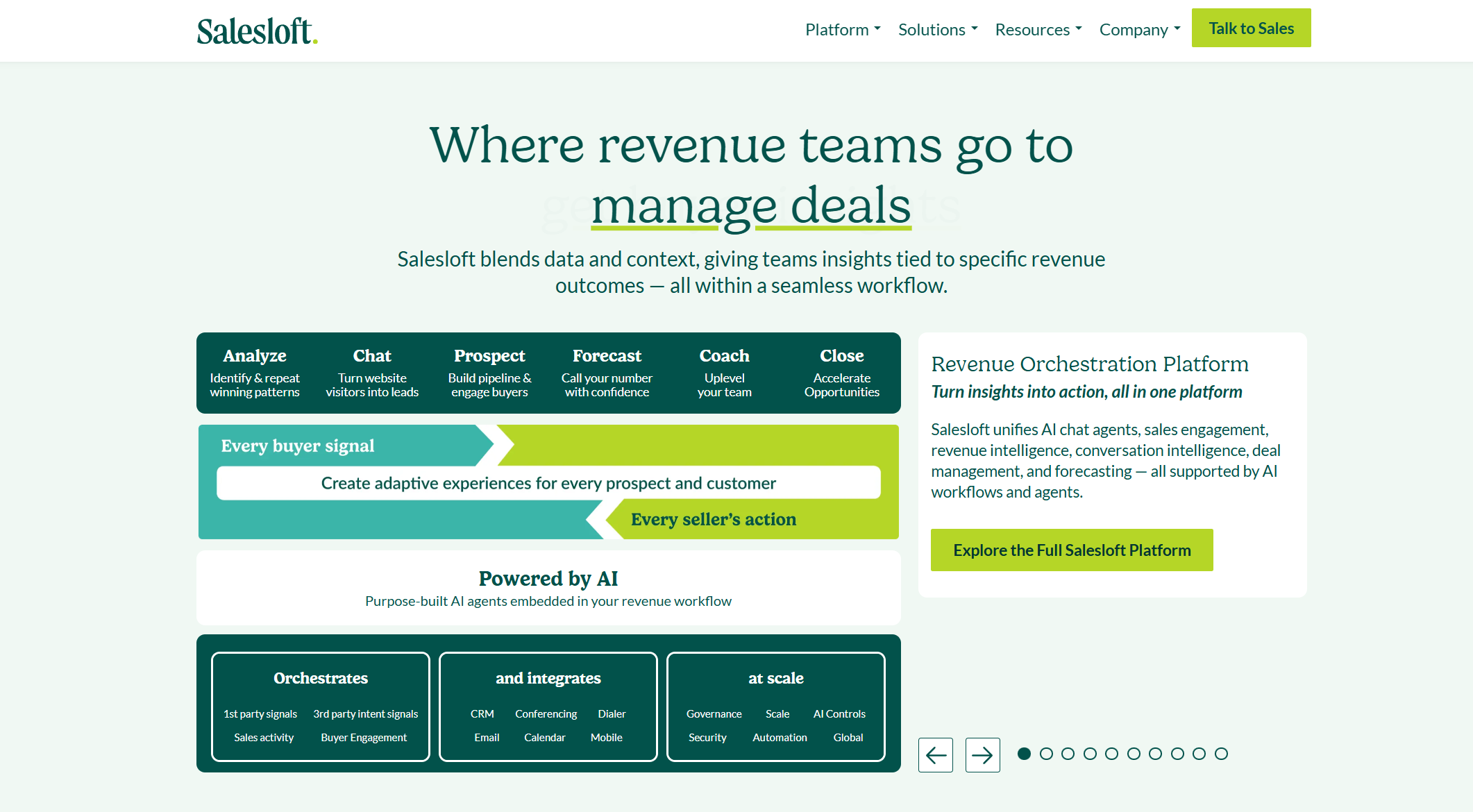
🔧 Key Features
- Cadence automation: Multi-touch sequences combining emails, calls, LinkedIn tasks with conditional logic
- Dialer integration: Built-in power dialer with local presence and call recording
- Email tracking: Open/click tracking, A/B testing, and template management
- Task prioritization: Daily task lists organizing prospect outreach by priority
- Conversations (CI product): Call recording and basic transcription (criticized as "very poorly built")
- Salesloft Rhythm: AI-powered next-best-action recommendations (limited effectiveness)
💰 Pricing
- Engagement platform: $100-$200/user/month
- Does not include robust CI or forecasting, forcing additional tool purchases
- Implementation: 6-8 weeks with moderate training requirements
✅ Pros
- Best-in-class engagement: Superior to Gong Engage and Outreach for SDR cadence workflows
- Dialer quality: Reliable power dialer with good call quality and local presence features
- Email deliverability focus: Tools to optimize sending patterns and avoid spam filters
- Salesforce integration: Solid bi-directional sync with activity logging
❌ Cons
- "Very poorly built" CI: Conversation intelligence only works for calls made through Salesloft dialer, missing external meetings
- Forecasting rated 1/10: Virtually no forecasting capability forces separate tool purchase
- Built for obsolete prospecting era: Salesloft and Gong Engage designed for "mass, non-personalized prospecting" now ineffective due to email platform crackdowns and buyer fatigue
- High friction for multi-tool setup: Users juggle Salesloft (engagement) + Gong (CI) + Clari (forecasting) = fragmented workflows
- Support quality decline: Users report "horrible customer service," ticketing system auto-closes cases after 48 hours regardless of resolution
🎯 Use Cases & Ideal Customer Profile
Best For:
- SDR/BDR-focused organizations (20+ outbound reps) needing robust cadence management
- Teams willing to stack separate CI/forecasting tools and manage multi-vendor complexity
- Enterprise with established engagement workflows where switching costs outweigh limitations
💬 Real User Feedback
"Salesloft is not very intuitive, especially in the beginning. The setup process was overwhelming, and we had to go through extensive training as a team, which was tiring. Customer support is not convenient too."
Verified User, Mid-Market Company, G2 Verified Review
"Super clunky to set up. Conversations doesn't work at all. They sell it as a Gong competitor. It doesn't even have the functionality of Zoom. Their customer service is horrible. My company has been trying to get in touch with someone there for over 5 months with no response."
Verified User, Professional Training & Coaching, G2 Verified Review
5. Outreach - Sales Execution & Sequencing Platform ⭐⭐⭐ [toc= 5. Outreach]
What It Does
Outreach is a sales execution platform competing directly with Salesloft in the engagement space. The platform combines email sequencing, task management, and sales analytics in a unified interface. Outreach historically served enterprise customers with complex, multi-persona outreach campaigns.
Like Salesloft, Outreach's Kaia conversation intelligence product receives poor user feedback, described as "lightweight" and "not very good." The platform faces the same "obsolete prospecting era" challenge built for bulk emailing workflows now ineffective post-Google/Microsoft crackdowns.
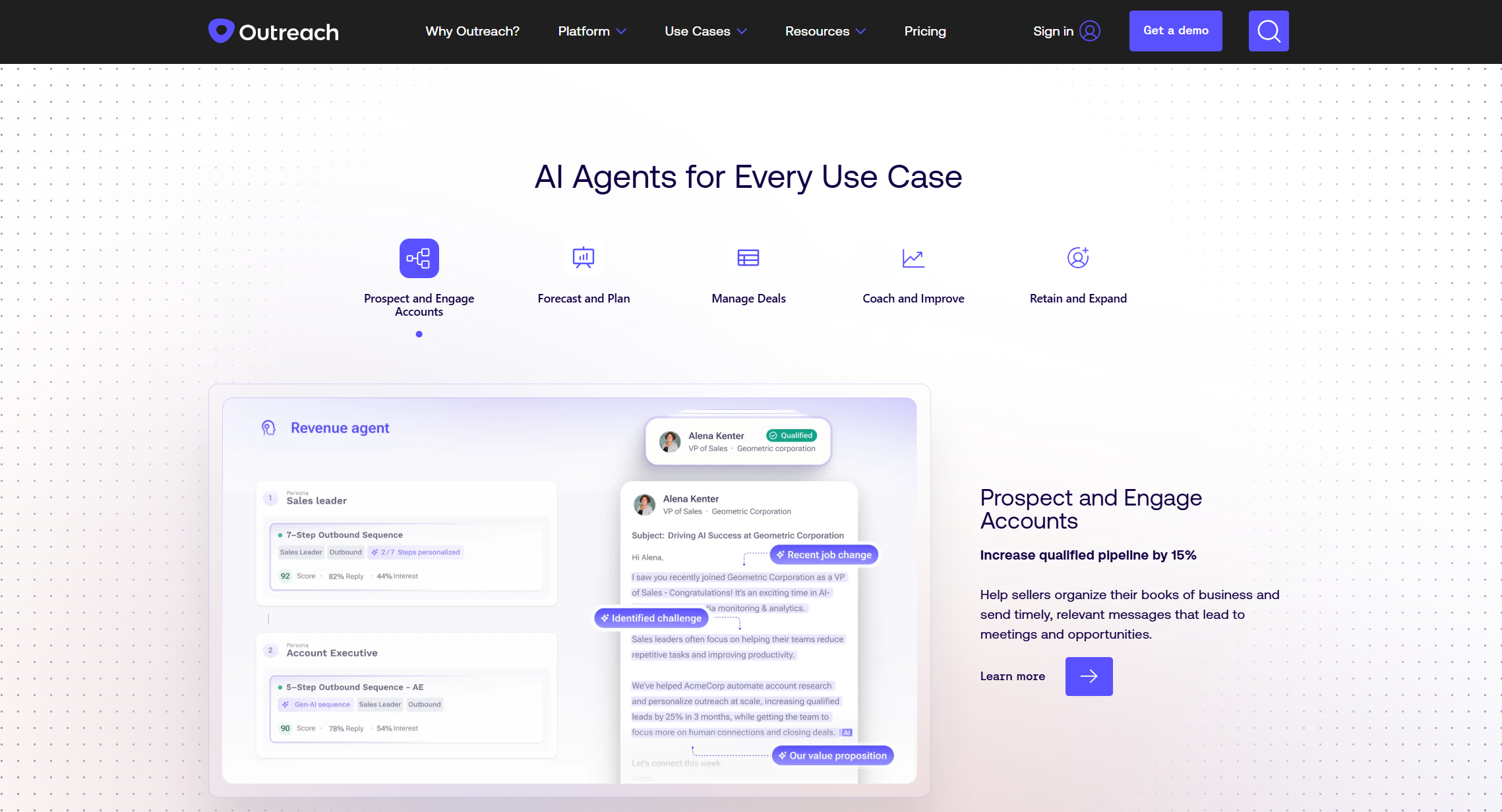
🔧 Key Features
- Sequencing workflows: Multi-step email/call campaigns with conditional branching
- Email automation: Template management, A/B testing, and send-time optimization
- Kaia (Conversation Intelligence): Basic call recording and transcription (market feedback: weak product)
- Meetings scheduling: Calendar integration and automated booking links
- Reporting & analytics: Sequence performance metrics and rep activity dashboards
💰 Pricing
- Platform pricing: $100-$500/user/month depending on tier and feature access
- Enterprise contracts with auto-renewal: Users report "predatory contracts" and inflexibility on cancellations
- Implementation: 4-6 months for enterprise deployments
✅ Pros
- Enterprise-grade sequencing: Handles complex, multi-persona campaigns at scale
- Integration breadth: Connects with Salesforce, HubSpot, LinkedIn, and major sales tools
- Reporting capabilities: Strong analytics on email performance and sequence effectiveness
❌ Cons
- Weak conversation intelligence: Kaia product considered inferior to Gong/Oliv AI
- Stagnant product development: Users report "same features, UX, integrations and issues as it had 5 years ago"
- Pricing inflexibility: "Significantly overpriced," "predatory contracts," auto-renewal enforcement
- No HubSpot native integration: Integration via third-party causes frequent sync breaks
- Support quality issues: "Reports are difficult to make sense of," "account manager changed 3 times in 4 months," "24-hour response times"
🎯 Use Cases & Ideal Customer Profile
Best For:
- Enterprise sales organizations (500+ reps) with established Outreach workflows where switching costs are prohibitive
- Teams prioritizing engagement exclusively and using separate tools for CI/forecasting
💬 Real User Feedback
"Outreach is significantly overpriced for what it offers. The platform has a clunky interface and still relies on your own email servers, essentially functioning as an email scheduler with very basic reporting capabilities. Their agreements are evergreen automatically renewing annually without alternative terms. If you miss the cancellation deadline by even a few hours, they enforce renewal for the entire year without any willingness to negotiate."
Kevin H., CTO/Co-Founder, Small Business, G2 Verified Review
"The engage product is stagnant. Looks to have the same features, UX, integrations and issues as it had 5 years ago. Frequent requests for a product roadmap or understanding how AI is involved is glossed over by the CS team."
Matthew T., Head of Revenue Operations, Mid-Market Company, G2 Verified Review
6. Chorus.ai by ZoomInfo - Conversation Analytics Add-on ⭐⭐ [toc= 6. Chorus AI]
What It Does
Chorus.ai was once a strong Gong competitor before its 2022 acquisition by ZoomInfo. Post-acquisition, Chorus has "failed to innovate" and is now "very behind" technologically, with simpler tools like Fireflies.ai considered better alternatives. The platform functions primarily as a basic call recording add-on to ZoomInfo's lead intelligence database.
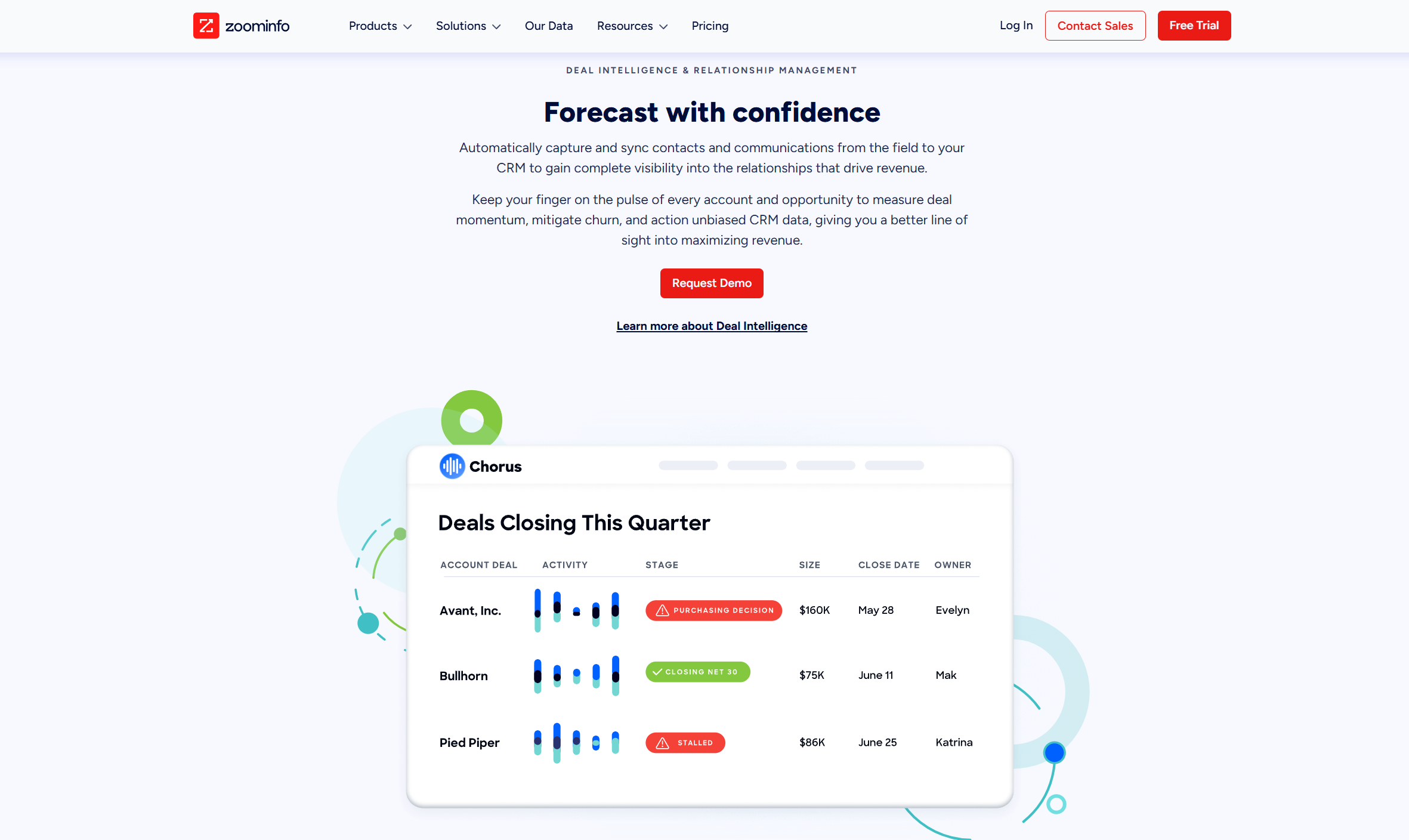
🔧 Key Features
- Basic call recording: Captures and transcribes Zoom meetings and calls
- Keyword tracking: Simple mention detection (pre-AI technology)
- Shareable snippets: Clip and share call segments internally
- ZoomInfo integration: Syncs conversation data with ZoomInfo contact records
💰 Pricing
- Add-on pricing: $20-$40/user/month on top of ZoomInfo platform fee
- Cannot purchase standalone: Requires ZoomInfo subscription ($10K+ annually)
- High seat counts: Price drops to $20-30/user for 100+ seats
✅ Pros
- Low per-seat cost: Cheapest option if already using ZoomInfo
- Simple setup: Basic functionality requires minimal configuration
❌ Cons
- Technologically obsolete: "Very behind," "very poor product," failed to innovate post-acquisition
- Requires ZoomInfo purchase: Cannot buy standalone, forcing $10K+ annual commitment
- Limited AI capabilities: Pre-AI keyword tracking vs. generative AI contextual understanding
- Poor user experience: "AI email could be better it repeats items up to 3 times in summaries"
🎯 Use Cases & Ideal Customer Profile
Best For:
- Existing ZoomInfo customers seeking basic call recording at minimal incremental cost
Avoid If: Seeking modern AI-driven conversation intelligence; better alternatives include Oliv AI, Gong, or even Fireflies.ai
💬 Real User Feedback
"Trying to find where I could import previous calls or videos was very frustrating. Why in the world is it inside settings and then halfway down as an option? Is this something you don't want people using? Otherwise, what's the reason for hiding it or making it so challenging to find?"
Verified User, ZoomInfo Chorus Customer, G2 Verified Review
7. Salesforce Einstein - CRM-Native AI Intelligence ⭐⭐⭐ [toc= 7. Salesforce Einstein]
What It Does
Salesforce's Einstein and Agentforce represent two generations of AI: older Einstein (launched ~2018) and newer Agentforce (2024). The solutions theoretically provide CRM-native intelligence conversation insights, activity capture, and AI-powered forecasting but suffer from prohibitive costs, complex implementations, and product quality issues.
A critical limitation: Einstein/Agentforce "fail in environments with unclean CRM data" (duplicate accounts/contacts) a problem affecting most companies. The systems use "brittle, rule-based logic that gets confused easily." Additionally, Salesforce has shifted Agentforce focus to B2C customer support use cases, leaving B2B sales "very underserved."
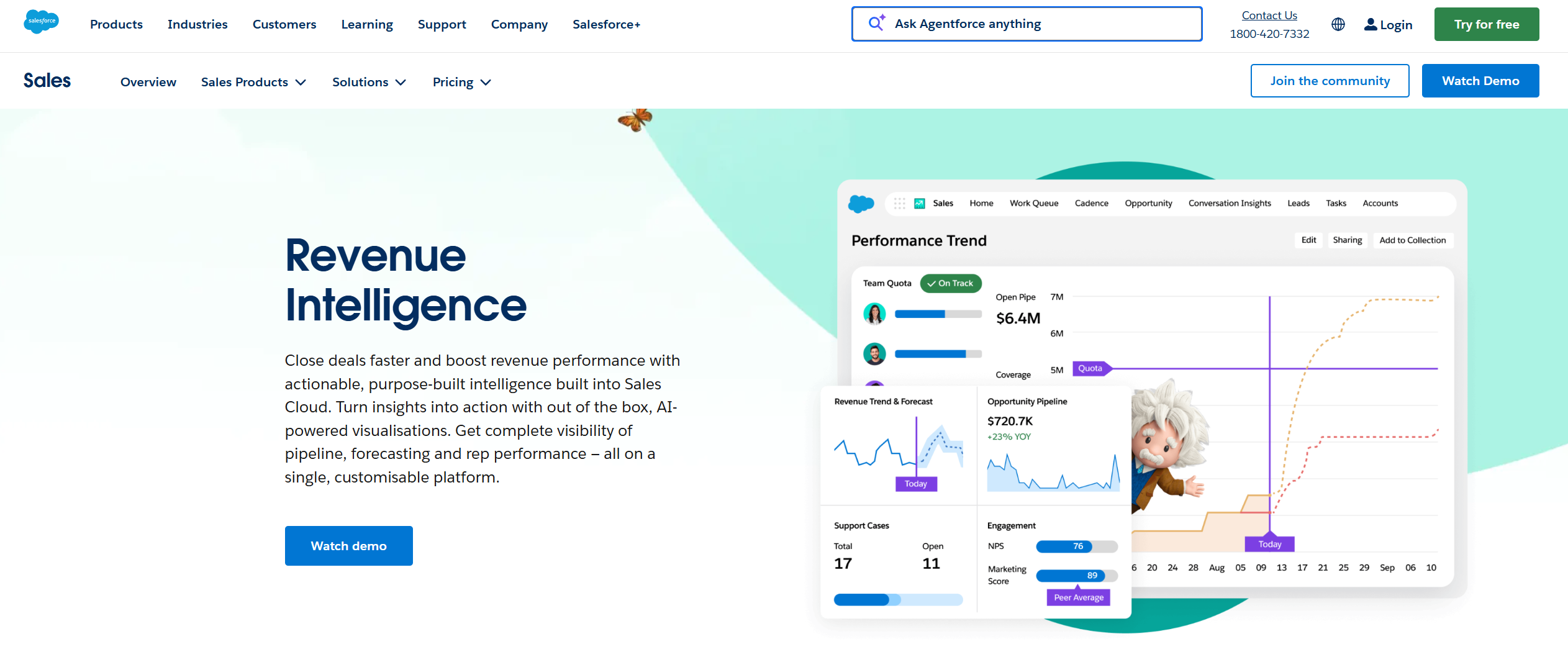
🔧 Key Features
- Einstein Conversation Insights: Call recording and transcription (Gong equivalent)
- Einstein Activity Capture: Automatically logs emails/meetings to CRM
- Agentforce for Sales: AI agents for lead prioritization and next-best actions
- Revenue Intelligence: Pipeline analytics and forecasting
- Sales Engagement: Email sequences and task management
💰 Pricing
Salesforce's modular, complex pricing creates confusion and high TCO:
- Agentforce for Sales: $125/user/month
- Einstein Conversation Insights: $50/user/month (up to $500/user for full suite)
- Revenue Intelligence: $220/user/month
- Sales Engagement: $50/user/month
- All are add-ons to base Salesforce licenses
- Implementation: Often takes years vs. days for modern tools
✅ Pros
- Native Salesforce integration: No third-party connectors required
- Unified CRM ecosystem: Single vendor for CRM + AI intelligence
❌ Cons
- Prohibitively expensive: $500/user/month for full Einstein Conversation Insights suite
- Fails with unclean CRM data: Brittle logic breaks with duplicates/incomplete records common scenario
- Einstein Activity Capture problems: "Fails to associate activities with correct opportunities, redacts information unnecessarily, stores data in separate AWS instance unusable for downstream reporting"
- Pre-LLM machine learning: Einstein built on older ML technology, not generative AI
- B2C focus: Agentforce prioritizes chatbots and consumer support; B2B sales "very underserved"
- Years-long implementations: Enterprise deployments take 12-24+ months
🎯 Use Cases & Ideal Customer Profile
Best For:
- Salesforce-committed enterprises with clean CRM data, large budgets, and preference for single-vendor ecosystems
Avoid If: Budget-conscious, need fast deployment, have typical CRM data quality issues, or prioritize B2B sales use cases
💬 Real User Feedback
"It can be complex to set up and often requires skilled administrators or developers to customize and integrate properly, which adds time and cost. Licensing fees can be high, especially as the number of agents grows. Out-of-the-box insurance-specific features are limited unless you're using add-ons like Financial Services Cloud or third-party solutions, which may require further customization."
Verified Reviewer, Insurance Industry, G2 Verified Review
For pricing details, see Salesforce Einstein pricing breakdown and Agentforce pricing analysis.
8. Revenue Grid - Salesforce Activity Capture & Guidance ⭐⭐⭐ [toc= 8. Revenue Grid]
What It Does
Revenue Grid (formerly SmartCloud Connect) is a Salesforce-native activity capture and sales engagement platform focused on automating CRM data entry and providing AI-driven deal guidance. The platform captures emails, meetings, and calls, then logs them to Salesforce automatically while offering pipeline insights and next-best-action recommendations.
Revenue Grid's positioning targets Salesforce-committed teams seeking lighter-weight alternatives to Gong/Clari, offering faster implementation (2-3 weeks) and lower entry pricing ($30/user/month starting point).
🔧 Key Features
- Activity Capture 360: Automatically logs emails, meetings, and calls to Salesforce
- Knowledge Capture: Converts captured activities into intelligence and insights
- Revenue Grid Ultimate: Complete pipeline visibility, forecasting, and AI-guided selling
- Guided Selling: AI-powered next-step recommendations and deal risk alerts
- Email Sequences: Basic sales engagement and follow-up automation
💰 Pricing
- Activity Capture 360: $30/user/month (basic activity logging)
- Knowledge Capture: $49/user/month (adds intelligence layer)
- Revenue Grid Ultimate: $149/user/month (full forecasting and analytics)
- Implementation: 2-3 weeks for standard deployments
✅ Pros
- Salesforce-native design: Deep integration eliminates third-party connector issues
- Fast implementation: 2-3 week deployments vs. months for competitors
- Transparent tiered pricing: Clear $30/$49/$149 progression without hidden platform fees
- Compliance certifications: GDPR, HIPAA, ISO 27001, SOC 2 Type 2, CCPA/CPRA
❌ Cons
- Salesforce dependency: Only works with Salesforce CRM, no HubSpot/Dynamics support
- Limited conversation intelligence: Basic call recording vs. advanced CI capabilities of Gong/Oliv
- Smaller feature set: Narrower scope than full revenue orchestration platforms
- Manual data entry for insurance: Users report needing manual inputs for certain workflows
🎯 Use Cases & Ideal Customer Profile
Best For:
- Salesforce-native sales teams (50-500 employees) seeking CRM automation without heavy CI investments
- Organizations prioritizing activity capture over advanced forecasting/conversation analytics
- Budget-conscious teams ($30-149/user vs. $250+ for Gong)
💬 Real User Feedback
"Revenue Grid enhances sales engagement and forecasting through AI-driven automation and analytics. Real-time deal guidance, pipeline insights, and compliance support ensure teams maintain accuracy and close rates. It remains a strong choice for organizations seeking to streamline sales operations."
G2 Verified Review (4.8/5 rating)
9. Apollo - Data-Driven Sales Intelligence & Prospecting ⭐⭐⭐ [toc= 9. Apollo]
What It Does
Apollo.io is a data-first sales intelligence and prospecting platform combining a 210M+ contact database with sales engagement sequencing. The platform's core strength lies in lead generation helping SDRs find contacts, enrich data, and launch outbound campaigns. Apollo differs from conversation intelligence platforms (Gong, Oliv) by focusing on top-of-funnel prospecting rather than deal-level intelligence.
🔧 Key Features
- Contact database: 210M+ contacts, 35M+ companies with 65+ data points and 200+ filters
- Prospecting tools: LinkedIn Chrome extension, buyer intent data, technographics, ICP builder
- Email sequences: Cold email automation, A/B testing, LinkedIn tasks
- Dialer: US/international calling with basic call recording
- CRM integrations: Native Salesforce, HubSpot, and Zapier connectors
💰 Pricing
- Free tier: Limited credits for testing
- Paid plans: $49-$149/user/month depending on features and seat count
- Credit-based system: Certain data enrichment actions consume credits, leading to "surprise credit burns"
✅ Pros
- Massive contact database: 210M+ contacts with buyer intent and technographic data
- Affordable entry point: $49/user vs. $250+ for Gong
- LinkedIn integration: Chrome extension for seamless prospecting workflows
- Fast implementation: 1-2 week deployments for SMBs
❌ Cons
- Limited conversation intelligence: Basic call recording, no advanced CI capabilities
- Data accuracy issues: "Phone number accuracy is low," "false positives for mobile numbers"
- Small niche ICP volumes: "Small lead volume for niche ICPs (e.g., content marketers in Europe)"
- Generic AI outputs: "AI copy is robotic," "outputs are glitchy and generic"
- No real-time intelligence: Lacks pipeline forecasting, deal risk alerts, or contextual coaching
- Credit burn frustrations: Users report unexpected credit consumption on filter changes
🎯 Use Cases & Ideal Customer Profile
Best For:
- Outbound-focused SMBs (<100 employees) needing affordable lead generation and basic sequencing
- SDR/BDR teams prioritizing contact discovery over conversation analytics
- Startups seeking all-in-one prospecting + engagement at entry-level pricing
Avoid If: Prioritizing conversation intelligence, deal-level forecasting, or CRM automation Apollo lacks these capabilities
💬 Real User Feedback
"Apollo is incredibly useful and super simple to use. I mainly use it for getting prospect data into the CRM to help with sequencing. The LinkedIn extension really makes it easy to find relevant information quickly. My only con is that if it cannot find a valid email for a prospect then you aren't able to push them to the CRM."
Verified User, Sales Professional, Capterra Review
"Apollo.io tackles the issue of buyer urgency and intent. We are able to contact prospects indicating our intent by using the intelligence tools at our disposal. However, I feel disappointed with their customer support; sometimes they are not so responsive when you hardly need their support. Their phone number accuracy and the stack details still need to be improved."
Verified User, Enterprise Customer, Capterra Review
Summary: Choosing the Right Revenue Intelligence Platform for 2026
The revenue intelligence market in 2026 presents sales leaders with a clear choice: legacy pre-generative AI platforms requiring extensive manual adoption and fragmented tooling (Gong + Clari stacks costing $500/user/month), or AI-native orchestration platforms that autonomously execute revenue workflows through specialized agents.
For most organizations, Oliv AI delivers the optimal combination of unified platform economics (single solution replacing Gong + Clari), generative AI-native architecture enabling true contextual understanding, autonomous agent workflows eliminating manual tasks, and transparent modular pricing without hidden platform fees addressing every major pain point plaguing legacy tools.
Legacy platforms remain viable in specific scenarios: Gong for enterprise teams with existing deployments and sunk training costs, Clari for VP/C-level buyers prioritizing its specific roll-up UI, Salesloft for large SDR organizations focused purely on engagement cadence, and Revenue Grid for Salesforce-native teams seeking lightweight activity capture.
Avoid Chorus.ai (technologically obsolete post-acquisition), Salesforce Einstein (prohibitive costs, B2C focus, fails with unclean data), Outreach (stagnant product, inflexible contracts), and Apollo (limited to prospecting, no deal intelligence).
The shift from Revenue Intelligence to AI-Native Revenue Orchestration represents the category's future where autonomous AI agents proactively execute workflows rather than requiring sales teams to adopt, train on, and manually operate yet another SaaS dashboard.
Ready to eliminate the "$500/user fragmentation problem" and deploy AI-native revenue orchestration? Book a free AI strategy session with Oliv's founding team to audit your current stack, calculate TCO savings, and design a custom agent implementation roadmap.
Q2. What Exactly is Revenue Intelligence and Why Does it Matter in 2026? [toc=Revenue Intelligence Definition]
Revenue Intelligence emerged as a critical sales technology category between 2015-2018 when pioneers like Gong introduced tools that captured, analyzed, and derived insights from customer interactions. The term encompasses conversational intelligence (call recording, transcription, conversation analysis), forecasting capabilities (pipeline prediction, deal risk assessment), and CRM automation (activity logging, data enrichment). Historically, many users defaulted to the narrower term "Conversational Intelligence" to describe these foundational capabilities, though Revenue Intelligence serves as the broader umbrella category addressing the complete revenue process.
❌ The Legacy Pre-AI Foundation
The revenue intelligence market was fundamentally built on pre-Generative AI technology during the 2015-2022 era. Legacy platforms like Gong and Clari rely on keyword trackers (monitoring competitor mentions, pricing discussions, objection patterns) and basic activity tracking (email counts, meeting frequency) to interpret deal health. This approach provides a "very poor picture of the deal" because it fails to distinguish between valuable, intent-driven engagements and random follow-up activity. For instance, keyword trackers struggle to differentiate whether a prospect merely mentioned a competitor versus actively evaluating multiple vendors, a critical distinction for accurate forecasting. These tools operate as traditional "SaaS software that you have to adopt and train your team to use," requiring substantial manual effort for adoption, ongoing configuration management, and extensive RevOps resources to maintain integrations.
⭐ The AI-Era Transformation
The AI-era transformation represents a fundamental shift from Revenue Intelligence to what the market now calls AI-Native Revenue Orchestration. This evolution marks the transition from coordination of existing systems to actual engineering and automation of revenue workflows. Generative AI's ability to understand contextual intent versus simple keyword matching enables platforms to analyze conversation sentiment, multi-threaded stakeholder relationships, and email engagement patterns holistically. Rather than dashboards requiring human interpretation, autonomous AI agents proactively complete tasks updating CRM records, generating forecast reports, drafting personalized prospecting messages directly where revenue teams work (email, Slack, CRM). Even category pioneer Gong acknowledged this shift by rebranding from "revenue intelligence platform" to "revenue AI platform" to reflect market demand for AI-centric solutions.
✅ Oliv AI's AI-Native Approach
Oliv AI positions itself as the first true AI-Native Revenue Orchestration platform, architected from inception on generative AI and autonomous agent technology rather than retrofitting AI capabilities onto legacy SaaS infrastructure. The platform's GPT-native architecture enables sophisticated analysis of conversation context, sentiment, and complex sales frameworks (MEDDIC, BANT, SPICED scorecards) that legacy keyword systems cannot achieve. Specialized AI agents perform work autonomously: the Forecaster Agent automates bottom-up forecasting and Monday meeting prep decks, the CRM Manager Agent populates structured CRM fields automatically (not just notes), and the Prospector Agent conducts deep account research and generates personalized messaging. Critically, Oliv provides deal-level understanding by unifying data from all sources across the entire sales cycle, overcoming the "meeting-level" analysis limitations of competitors that analyze conversations in isolation.
"Moving from manual forecast prep to Oliv's Forecaster Agent reduced our weekly pipeline review time from 8-10 hours to 30-minute reviews while improving forecast accuracy by 40%. The AI doesn't just track keywords, it understands deal context across months of interactions."
VP of Sales, Series B SaaS Company
The shift to AI-Native Revenue Orchestration matters in 2026 because legacy tools' pre-AI origins, high costs (Gong + Clari stacks costing ~$500/user/month), and fragmented capabilities make them increasingly obsolete for modern B2B environments requiring autonomous execution rather than manual dashboard management.
Q3. What are the Best Revenue Intelligence Platforms for Startups (<50 Employees)? [toc=Best Platforms for Startups]
Startups evaluating revenue intelligence platforms face unique constraints: limited budgets (<$5K/month total revenue tech spend), small sales teams (3-15 reps), need for rapid deployment (days not months), and avoidance of enterprise complexity that drains limited resources. The ideal platform must deliver immediate time-to-value on high-impact workflows (CRM hygiene, basic forecasting, call recording) without extensive training, RevOps resources, or multi-month implementations that kill startup agility.
❌ Prohibitive Legacy Barriers
Traditional revenue intelligence platforms present prohibitive barriers for startups. Gong's $5K minimum platform fee plus per-user costs of $250/month make it financially inaccessible for pre-Series B companies, a 10-person team would pay $30K+ annually before implementation fees. Clari requires enterprise sales cycles with multi-month procurement processes unsuitable for fast-moving startups needing tools deployed this quarter. Salesloft is built for SDR teams of 20+ reps with dedicated outbound managers, overkill for lean startup sales motions. The 3-6 month implementation timelines these platforms require, demanding RevOps resources, Salesforce admin time, and vendor professional services, represent opportunity costs startups cannot afford. Legacy vendors' focus on enterprise feature sets (complex forecasting hierarchies, advanced permissions, custom integrations) overwhelms small teams needing core functionality delivered simply.
⭐ Modern AI-Native Requirements
Modern AI-native platforms should offer freemium entry points allowing teams to test core functionality before committing budgets, self-serve onboarding eliminating dependency on vendor professional services, pay-as-you-grow pricing without minimum seat counts or platform fees, and immediate time-to-value (48-72 hour deployments). The focus should prioritize automating high-impact workflows, forecasting transparency for founders/CROs, CRM hygiene reducing rep administrative burden, call recording for coaching, versus enterprise feature bloat. Transparent pricing models without hidden implementation or training costs enable budget-conscious startups to accurately model TCO.
✅ Oliv AI for Startups
Oliv AI for startups addresses these constraints directly with a $0/user unlimited recording tier providing call transcription and basic summaries, allowing teams to start immediately without budget commitments. The Standard plan delivers core revenue intelligence (meeting insights for Sales/CS, deal scorecards, email+call intelligence) with transparent pricing and 48-hour implementation via Calendly integration requiring <5 hours total team time. Critically, Oliv's modular agent architecture allows startups to purchase only needed capabilities, for example, a Series A company might deploy only the Forecaster Agent for weekly pipeline clarity without paying for full-platform seats. No platform fees, no implementation charges, no training costs, total transparency enabling accurate budget forecasting. The platform scales seamlessly as startups grow, avoiding forced migrations to enterprise tools at Series B/C.
"As a 12-person startup, Gong quoted us $60K annually plus $15K implementation. Oliv deployed in 2 days for under $3K annually, giving us better AI-driven insights and automated CRM updates that Gong required manual configuration to achieve. The ROI was immediate."
Founder & CEO, Series A FinTech Startup
Brief alternatives: Revenue Grid's Salesforce-native option starts at affordable entry points (~$30-70/user) for lightweight CRM automation. Apollo suits outbound-focused startups needing prospecting data and basic sequences (~$49-99/user). Avoid Gong, Clari, Salesforce Einstein entirely due to cost, complexity, and enterprise sales cycles misaligned with startup velocity. Chorus.ai, while cheaper as ZoomInfo add-on, requires the broader ZoomInfo platform purchase, negating cost advantages.
Q4. What are the Best Revenue Intelligence Platforms for Mid-Market Companies (50-500 Employees)? [toc=Mid-Market Platforms]
Mid-market organizations require robust forecasting for complex, multi-stage pipelines spanning 6-18 month sales cycles, coaching at scale (managers overseeing 10-50 reps), RevOps automation reducing manual data analysis burden, and integration depth across mature tech stacks (Salesforce, email platforms, calendaring). However, mid-market buyers face intense budget scrutiny (CFO-approved software spend), rejection of enterprise vendor lock-in with inflexible contracts, and demand for measurable ROI within 90 days.
❌ The $500/User Fragmentation Problem
The "stack fragmentation problem" plagues mid-market buyers: companies historically purchased Gong ($250/user/month bundled including Engage + Forecast + CI) for conversation intelligence capabilities plus Clari ($200/user/month with Copilot CI product) for roll-up forecasting, totaling ~$500/user/month before platform fees and implementation costs. This dual-tool approach creates data silos (conversation insights in Gong, forecast data in Clari, activity logs in Salesforce), workflow redundancy (managers switching between three platforms for pipeline reviews), and dual vendor management overhead (separate contracts, support channels, product roadmaps). Salesloft's CI product is rated "very poorly built," functioning only for calls made through its dialer, forcing additional Gong purchases. The implementation burden compounds, two separate 2-4 month rollouts, two training programs, two RevOps integration projects, delaying time-to-value by 6+ months.
⭐ Unified AI-Native Platforms
Unified platforms leveraging Generative AI eliminate this fragmentation by delivering conversational intelligence, bottom-up forecasting, and engagement capabilities in a single system. The AI enables automated forecast prep, eliminating the 8-10 hours weekly managers spend manually reviewing pipeline before Monday forecast meetings. Automated coaching scorecards replace manual call review where managers spend off-hours listening to recordings and filling out MEDDIC assessments. A single source of truth integrates all customer touchpoints, calls, emails, meetings, CRM activity, providing holistic deal intelligence versus siloed point solutions.
✅ Oliv AI for Mid-Market
Oliv AI for mid-market provides a single platform replacing Gong + Clari at dramatically lower TCO, the Supreme tier delivers comprehensive revenue orchestration (deal scorecards, combined call/email intelligence, forecasting, CRM automation) with modular agent add-ons. The Forecaster Agent automates weekly pipeline reviews, Monday forecast meeting prep, and deal risk identification that previously consumed manager time. The CRM Manager Agent ensures data hygiene by populating structured Salesforce fields automatically, addressing the pain point where Gong only logs notes requiring RevOps custom coding for extraction. The Coach Agent delivers automated performance gap analysis without manual scorecard creation. Total TCO runs ~80% lower than the Gong + Clari dual-stack approach while providing superior AI-driven insights versus legacy keyword tracking.
"We were spending $47K annually on Gong + Clari for our 90-person sales team, plus burning 20 hours/week of RevOps time extracting data from Gong's API. Oliv replaced both tools at $13K annually with automated CRM updates and forecasting that actually works."
Director of Revenue Operations, Mid-Market SaaS Company
Alternatives: Gong remains viable if CI-only focus is acceptable and budget allows $250/user despite weak forecasting. Clari suits VP/C-level buyers prioritizing its specific roll-up UI if willing to stack separate CI tool. Outreach for engagement-heavy workflows but expect weak CI/forecasting requiring additional purchases. Avoid Chorus.ai, "very behind post-ZoomInfo acquisition" with failed innovation.
Q5. What are the Best Revenue Intelligence Platforms for Enterprise Organizations (500+ Employees)? [toc=Enterprise Platforms]
Enterprise revenue intelligence deployments demand SOC2 Type 2, GDPR/CCPA compliance, data residency controls for multi-region operations, SSO/SAML authentication, advanced role-based permissions managing hundreds of users across divisions, multi-CRM support (Salesforce + HubSpot + Dynamics instances), API access for RevOps data science teams, executive rollup reporting for C-level visibility, and change management support orchestrating 100+ user rollouts across geographies.
❌ Legacy Enterprise Challenges
Gong remains the enterprise standard with the deepest feature set accumulated over a decade, extensive integration marketplace, and proven scale supporting 1000+ seat deployments. However, critical limitations persist: Gong's "wonky API" forces RevOps teams to write extensive custom code for data extraction and analysis, creating ongoing maintenance burden as Gong updates break integrations. 3-6 month implementation cycles require dedicated project teams, with $30K+ onboarding fees for 100-person deployments before annual license costs. Platform fees scale at $5K per 25 additional users, compounding costs. Clari provides strong roll-up forecasting preferred by VP/C-level leadership but its Copilot CI product remains weaker than Gong, perpetuating the dual-tool stack problem. Salesforce Einstein theoretically offers native CRM integration but fails with unclean CRM data (duplicate accounts/contacts affecting most enterprises), uses brittle rule-based logic, costs $500/user/month for Conversation Insights, and now focuses primarily on B2C customer support use cases, "B2B sales segment very underserved."
⭐ AI-Era Enterprise Considerations
AI-era enterprise considerations center on data portability (can historical recordings be exported if switching vendors?), security posture (how is conversation data encrypted, stored, and accessed?), and ROI on automation versus manual processes (quantified time savings, forecast accuracy improvements). The key question: does the platform serve as system of record (owning customer interaction data) or system of intelligence layered atop existing CRM as single source of truth? Generative AI enables contextual deal scoring (MEDDIC/BANT frameworks applied automatically) versus legacy keyword tracking that misses nuanced risks. Enterprise buyers increasingly prioritize platforms reducing RevOps burden over feature-rich tools requiring constant maintenance.
✅ Oliv AI for Enterprise
Oliv AI for enterprise addresses these requirements with SOC2 Type 2 certification, GDPR alignment, and full data export policy treating the customer's CRM (Salesforce/HubSpot) as single source of truth, alleviating data lock-in concerns. The spreadsheet-like RevOps interface eliminates custom API coding requirements plaguing Gong implementations, bulk analysis and reporting available without developer resources. 1-2 week enterprise deployments contrast sharply with Gong's months-long cycles, accelerating time-to-value. Transparent pricing without platform fees simplifies budget forecasting for finance teams. The modular agent architecture enables phased rollouts, starting with Forecaster Agent for sales managers, expanding to CRM Manager for reps, then Coach Agent for enablement, rather than forcing big-bang deployments. The innovative Voice Agent captures insights from in-person meetings and phone calls unavailable in competitor recording-only tools, critical for field sales organizations.
"Gong's implementation required 200 hours of custom Apex code from our Salesforce team to extract conversation data for RevOps analysis. Oliv deployed in 10 days with zero custom coding, providing better AI insights through spreadsheet exports our analysts actually use."
Senior Director of Revenue Operations, Enterprise SaaS Company (1200 employees)
When to consider legacy platforms: Gong if existing 500+ seat deployment with trained users makes switching costs disruptive. Clari if VP/C-level prioritizes its specific roll-up forecasting UI exclusively. Salesforce Einstein only if deep native integration outweighs subpar AI quality, prohibitive costs, and B2C focus. Salesloft for large SDR organizations (50+ seats) focused purely on engagement cadence where CI/forecasting covered by separate tools.
Q6. How Does Revenue Intelligence Improve Sales Forecasting Accuracy? [toc=Forecasting Accuracy]
Forecasting remains the #1 operational pain point for sales leaders in 2026. The typical workflow has managers spending 1-2 hours per rep every Thursday and Friday manually reviewing pipeline activity to prepare forecast submissions for Monday VP meetings. This labor-intensive process, consuming 8-10 hours weekly for managers overseeing 5-10 reps, stems from systemic challenges: rep optimism bias (deals marked 90% likely that are actually 30%), stale CRM data (outdated close dates, missing stakeholder changes), and inability to contextualize deal risks across dozens of simultaneous opportunities.
❌ The Legacy Forecasting Problem
Clari's roll-up system automates the consolidation layer (rep forecasts to manager rollups to VP to CRO) but still relies on manual rep inputs and activity-based signals (#emails sent, meeting counts, last activity date) that miss contextual deal health. A deal with 20 emails might be highly engaged or completely stalled, activity count alone cannot distinguish. Gong's forecast module (rated 4/10 by market analysts) tracks keywords like "competitor" or "budget" but cannot differentiate whether a prospect casually mentioned evaluating alternatives versus actively running a competitive bake-off, a critical forecast accuracy miss. Managers still spend hours manually reviewing call recordings and pipeline to submit their rollups, negating automation benefits.
⭐ AI-Era Bottom-Up Forecasting
Generative AI enables deal-level risk assessment by analyzing conversation sentiment (prospect enthusiasm declining over time), email engagement patterns (champion stopped responding), and multi-threaded relationships (only 1 contact engaged vs. 5-person buying committee) to predict close probability. This approach eliminates manual rep input and optimism bias, surfaces specific next actions ("Schedule executive briefing with CFO by Friday") vs. generic "follow up" tasks, and automates weekly pipeline review decks for manager 1-on-1s.
✅ Oliv AI Forecaster Agent Solution
The Forecaster Agent automates the entire workflow, analyzing all deal signals (calls, emails, CRM fields, stakeholder engagement) to generate unbiased AI forecasts with risk categorization (commit/likely/risk/pipeline). It produces one-page reports and presentation slides for Monday forecast meetings, identifies at-risk deals with specific remediation actions, and delivers weekly pipeline breakdowns for manager 1-on-1s. This reduces manager forecast prep from 8-10 hours to 30-minute reviews while improving accuracy by eliminating human bias. Unlike Clari's platform requiring full per-user licensing, the Forecaster Agent is available as a modular add-on for managers only.
"Oliv's Forecaster Agent cut our weekly forecast prep from 12 hours to 45 minutes while catching three at-risk $100K+ deals our manual process missed. The AI identified stakeholder disengagement patterns we couldn't see in Clari's activity metrics."
VP of Sales, Mid-Market SaaS Company
Q7. Why Legacy Revenue Intelligence Tools Struggle with CRM Data Hygiene (And How AI Agents Fix This)? [toc=CRM Data Hygiene]
The CRM data hygiene crisis affects 70% of organizations: duplicate accounts/contacts, outdated information, and incomplete fields render forecasts unreliable and Salesforce Einstein "brittle". Sales reps spend 2-3 hours daily on manual data entry versus selling, while RevOps teams write custom code to extract Gong conversation data due to its "wonky API." The root cause: traditional tools passively log interactions as notes without actively managing CRM structure.
❌ Traditional Passive Data Capture
Gong logs call summaries as a single "activity" note without updating structured opportunity fields (close date, stage, next steps, MEDDIC scores). Salesforce Einstein Activity Capture "fails to associate activities with correct opportunities, redacts information unnecessarily, and stores data in a separate AWS instance" unusable for downstream reporting, a verified pain point from enterprise users. Clari requires clean CRM inputs to function effectively but provides no data cleaning tools itself, a circular dependency problem. Manual rep entry remains the bottleneck, creating the "data entry tax" on sellers.
⭐ Agentic CRM Management Approach
AI-agent solutions don't just capture data, they actively structure, enrich, and maintain it. This means creating/updating contacts automatically, mapping them to correct accounts, populating custom fields based on conversation analysis, and progressing deal stages when MEDDIC criteria are satisfied. This eliminates the data entry burden on reps while ensuring RevOps has a reliable reporting foundation without manual cleanup efforts.
✅ Oliv CRM Manager Agent
The CRM Manager Agent automates updates across standard and custom fields (not just notes), creating/enriching contacts with email/LinkedIn data, mapping contacts to accounts, auto-progressing deal stages based on qualification framework completion, and capturing unstructured insights (competitor mentions, budget discussions, timeline changes) into structured Salesforce fields. For RevOps teams, Oliv provides a spreadsheet-like interface for bulk analysis without requiring API coding, addressing the "wonky API" frustration where Gong requires 200+ hours of custom Apex code for data extraction.
"We went from 15 hours per week cleaning CRM data to 2 hours reviewing Oliv's automated updates. The CRM Manager Agent caught 43 duplicate contacts and correctly mapped them before they caused forecast reporting errors."
Director of Revenue Operations, Enterprise SaaS Company
Q8. How is AI Transforming Sales Engagement and Prospecting (Beyond Bulk Email)? [toc=Sales Prospecting AI]
The era of spray-and-pray prospecting ended definitively in 2024-2025. Google and Microsoft now throttle bulk cold emails, buyer inboxes aggressively filter generic outreach, and response rates on templated cadences plummeted from 8% (2020) to <1% (2025). Effective prospecting now demands deep account research, custom hypotheses, and multi-threaded engagement plans, capabilities absent in engagement platforms built for volume.
❌ Obsolete Mass Prospecting Tools
Salesloft and Gong Engage excel at cadence automation, dialer integration, and task management but were "built for the obsolete paradigm of mass non-personalized prospecting." Outreach Kaia offers similar lightweight CI with engagement focus. Critically, none support research workflows: target account analysis, ICP fit scoring, buying committee mapping, or personalized hypothesis generation. Reps manually research for 2-3 hours per target account, then use these tools merely for sending, not creating compelling, personalized messaging.
⭐ AI-Powered 1-to-1 Prospecting at Scale
Generative AI enables true personalization at scale. An AI agent researches company financials, tech stack, recent news, hiring patterns, and competitive landscape; generates a custom account plan with sales hypothesis; identifies decision-makers and buying committee structure; and writes tailored emails referencing specific pain points versus generic templates. The rep reviews and sends rather than creates from scratch, shifting from hours to minutes per account while improving response rates dramatically.
✅ Oliv Prospector Agent
The Prospector Agent performs deep account research across LinkedIn, Crunchbase, news sources, job postings, and tech stack databases. It builds a custom account plan with ICP fit score and sales hypothesis, identifies 3-5 key contacts with role-based messaging angles, and generates personalized email drafts for rep review. Critically, it integrates with existing sequences (Salesloft/Outreach) for sending, avoiding platform replacement. Early customers report 18% response rates on Prospector-generated emails versus 5% on templated cadences, a 3.6x improvement. Available as an on-demand service versus platform fees charged by engagement tools.
"Our SDRs went from 15 accounts/day with templated emails (2% response) to 6 accounts/day with Prospector Agent research (22% response). The quality shift was immediate, prospects replied 'How did you know we were evaluating this?' The ROI justified itself in week one."
Director of Sales Development, Series B Company
Q9. What Should RevOps Teams Look for in a Revenue Intelligence Platform? [toc=RevOps Buying Criteria]
RevOps teams increasingly control revenue tech stack decisions due to their ownership of data governance, integration complexity, and TCO management. Primary concerns include API reliability (can we extract data for custom analysis?), data portability (can we export if switching vendors?), reporting flexibility (SQL access, spreadsheet exports), and avoiding vendor lock-in. The critical "adoption barrier" often centers on security/compliance: SOC2, GDPR, DPA certifications.
❌ Traditional RevOps Pain Points
Gong's API is "wonky", requiring extensive custom code to extract conversation data for analysis, with frequent breaking changes as Gong updates. Data is locked in proprietary formats with difficult export processes. Salesforce Einstein stores activity data "in a separate AWS instance unusable for downstream reporting," forcing parallel data warehousing. Clari requires clean CRM inputs but provides no cleaning automation, creating dependency on manual data hygiene efforts. The integration layer proves brittle, breaking with CRM updates and requiring constant RevOps maintenance.
⭐ AI-Era RevOps Requirements
Modern platforms should treat CRM as single source of truth versus creating parallel data stores, provide open data export (CSV, JSON, API access) eliminating lock-in, offer RevOps-friendly interfaces (SQL queries, spreadsheet views) versus requiring custom API coding, automate data cleaning rather than assuming clean inputs, and maintain audit trails for compliance verification.
✅ Oliv's RevOps-First Design
Oliv maintains Salesforce/HubSpot as the source of truth with bi-directional sync, offers a full open data export policy (no proprietary lock-in), and provides a spreadsheet-like interface for bulk analysis without API coding requirements. The platform is SOC2 Type 2, GDPR, and CCPA compliant with complete audit trails. Critically, the CRM Manager Agent cleans data proactively versus requiring clean inputs, a fundamental architectural advantage. Implementation requires zero custom RevOps code versus Gong's 3-6 month integration projects consuming 200+ development hours.
"Gong required 200 hours of custom Apex code from our Salesforce team just to extract conversation data for RevOps analysis. Oliv deployed in 2 days with zero coding, giving us better data exports than we ever got from Gong's API."
Senior Director of Revenue Operations, Enterprise Company
Industry trajectory:
Gong rebranded from "revenue intelligence platform" to "revenue AI platform," acknowledging the shift. Clari is "doubling down on Enterprise Revenue Orchestration" but remains constrained by pre-AI architecture. Salesforce Agentforce pivoted to B2C customer support, leaving B2B sales "very underserved." The 2026-2027 prediction: market consolidation as legacy vendors acquire AI capabilities or face replacement by orchestration-first platforms.
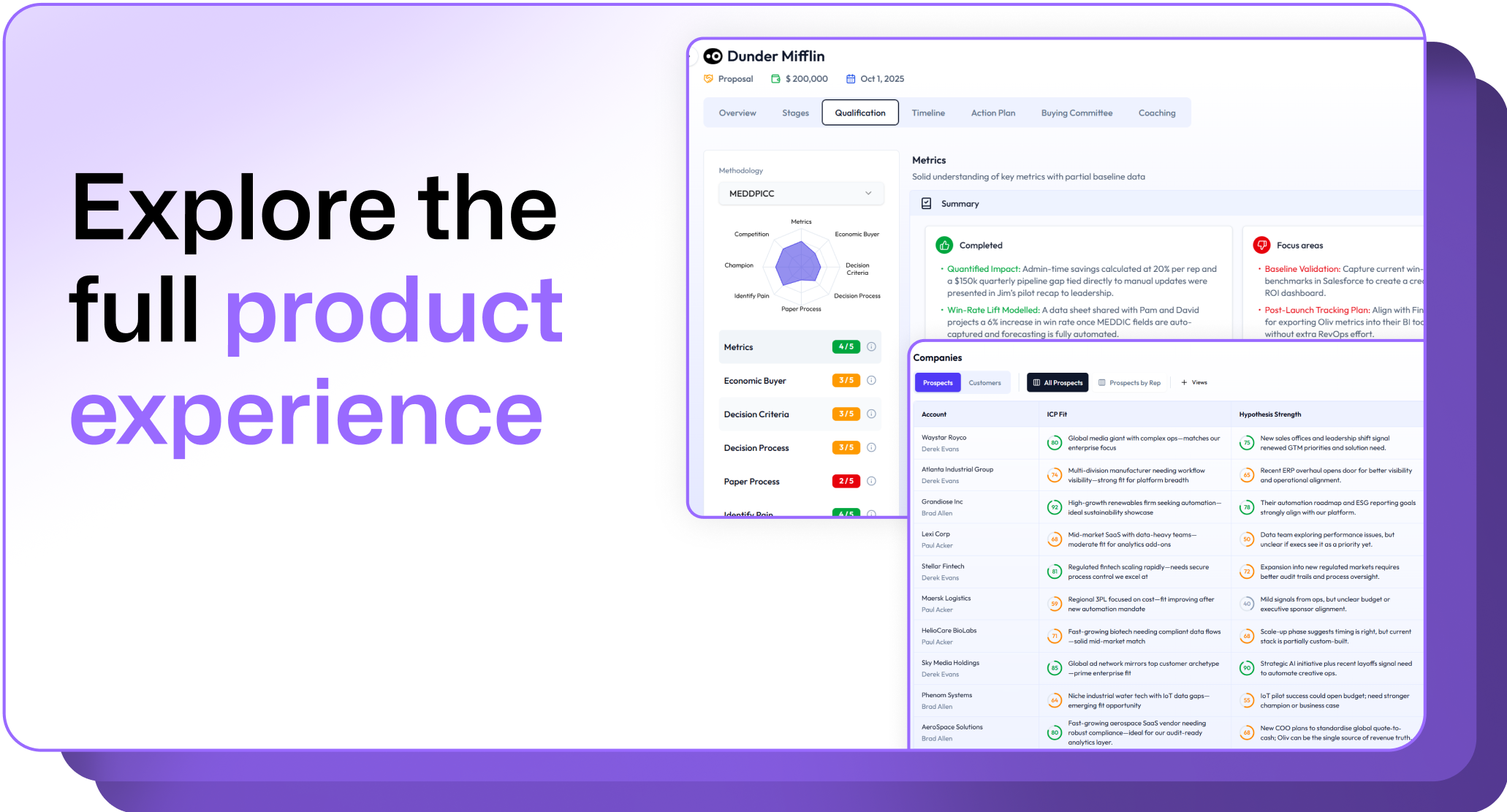
.png)
